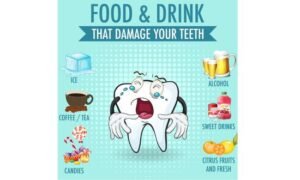Calcium stains on teeth can be a common concern for many people as it affects the appearance of their smiles. It occurs when there is excessive buildup of calcium deposits on teeth. It’s important to understand the causes of these stains and effective ways to prevent or treat them for maintaining good oral health.
How Calcium Deposits on Teeth Are Formed?
Calcium deposits on teeth are often referred as dental calculus or tartar. It results from a complex process involving minerals, bacteria and oral hygiene practices. This process starts when minerals in saliva accumulate on tooth surfaces which leads to the mineralization of bacterial plaque. This process is influenced by factors like poor oral hygiene and genetic predisposition which results in hardened deposits above and below the gum line.
What are Calcium Stains on Teeth?
Calcium stains on teeth occur when there is an excess buildup of calcium deposits on the tooth surfaces. These deposits can lead to discoloration which makes teeth appear yellow or brown.
Causes of Calcium Stains on Teeth
Calcium stains on teeth can be caused by various factors. It ranges from dietary habits to underlying medical conditions. Understanding these causes is essential for preventing and addressing the issue effectively. Some of the causes are:
1. Dietary Habits:
- Consuming an abundance of calcium-rich foods or supplements beyond the body’s requirement can contribute to the formation of calcium deposits on teeth.
- While dairy is an essential source of calcium, excessive intake can lead to deposits on teeth surfaces.

- In regions with high calcium content in water, prolonged exposure can result in deposits on teeth over time.
2. Poor Oral Hygiene:
Insufficient oral hygiene practices, such as irregular brushing and flossing, allow plaque and minerals like calcium to accumulate on the tooth surface, leading to stains.
3. Medical Conditions:
- Certain medical conditions, like metabolic disorders affecting calcium metabolism, can contribute to the formation of deposits on teeth.
- Individuals with chronic kidney disease may experience disturbances in calcium metabolism, leading to the deposition of calcium on teeth.
4. Saliva Composition:
Changes in the pH level of saliva can affect its ability to maintain a healthy balance of minerals. An imbalance can lead to the deposition of calcium on the teeth.
5. Medications:
- Overuse of calcium supplements, especially without proper medical guidance, can result in excess calcium in the body and contribute to staining.
- Some antacids contain calcium carbonate, and long-term use can contribute to calcium deposits on teeth.
6. Age-related Factors:
As individuals age, there may be changes in saliva composition and flow, influencing the risk of calcium deposits on teeth.
7. Genetic Factors:
Some individuals may be genetically predisposed to having a higher likelihood of developing calcium stains on their teeth.
8. Tobacco and Nicotine Use:
Smoking or using other tobacco products can result in the deposition of tar and nicotine on teeth, contributing to staining.
9. Environmental Factors:
Excessive exposure to fluoride, either through drinking water or dental products, can cause fluorosis, leading to the formation of white or brown spots on teeth.
10. Inadequate Water Intake:
Insufficient water intake can reduce saliva production, impacting its ability to cleanse the teeth and maintain a healthy mineral balance.
Signs and Symptoms of Calcium Stains on Teeth
1. Discoloration:
-
- Yellow or brown spots on teeth.
- Uneven coloring across the tooth surface.
2. Texture Changes:
Rough or gritty feeling on the teeth.
3. Increased Sensitivity:
Sensitivity to hot or cold substances.
Prevention of Calcium Stains on Teeth
Preventing calcium stains on teeth involves adopting a proactive approach to oral care, making mindful dietary choices, and maintaining a healthy lifestyle. Here are effective measures to prevent the formation of calcium deposits on your teeth:
1. Balanced Diet:
- Consume calcium in moderation, meeting the recommended daily allowances without excessive supplementation.
- Include a variety of foods in your diet, ensuring a balanced intake of essential nutrients for overall oral health.
- Brush your teeth at least twice a day using fluoride toothpaste to remove plaque and prevent the buildup of calcium deposits.
- Incorporate daily flossing into your oral care routine to clean between teeth and along the gumline, where toothbrushes may not reach effectively.
3. Limit Acidic Foods and Beverages:
Limit the consumption of acidic foods and beverages, as acidity can contribute to the breakdown of enamel and facilitate the formation of calcium deposits.
4. Stay Hydrated:
Ensure sufficient water intake throughout the day to promote saliva production. Saliva helps cleanse the teeth and maintain a healthy mineral balance. To keep track of your daily water intake check out our user friendly water intake calculator.
5. Regular Dental Check-ups:
- Visit your dentist regularly for professional cleanings. Dental professionals can remove hardened deposits that regular brushing may not address.
- Regular check-ups allow for the early detection of potential issues, enabling prompt intervention and prevention.
6. Avoid Tobacco and Nicotine:
Quit smoking and avoid the use of other tobacco products. Tobacco can contribute to the buildup of tar and nicotine on teeth, leading to stains.
7. Choose Fluoride Dental Products:
- Use fluoride toothpaste to strengthen enamel and make teeth more resistant to mineral deposits.
- If available, choose fluoridated water for drinking and cooking to support dental health.
8. Maintain Good Saliva Flow:
- Chewing sugar-free gum can stimulate saliva production, promoting a natural cleansing effect on teeth.
- Drink water during physical activities to stay hydrated and maintain saliva flow.
9. Address Underlying Health Conditions:
If you have medical conditions affecting calcium metabolism, work closely with your healthcare provider to manage them effectively.
Home Remedies for Calcium Stains
1. Baking Soda:
Gently scrubbing teeth with a paste of baking soda and water can help remove stains.
2. Apple Cider Vinegar:
Rinse with diluted apple cider vinegar to break down calcium deposits.
3. Oil Pulling:
Swishing coconut oil in the mouth may reduce bacteria and stains.
Professional Treatment Options
It’s important to consult with a dentist to determine the most suitable treatment plan based on the severity and underlying causes of calcium stains. Following are some of the available professional treatments for calcium stains removal:
1. Professional Scaling:
- Dentists perform scaling using special tools to remove hardened deposits, including calcium stains, from the tooth surfaces.
- Regular dental check-ups ensure timely scaling, preventing the buildup of stubborn stains.
2. Whitening Treatments:
- Dentists offer in-office whitening procedures using safe and effective bleaching agents to lighten the appearance of stains.
- Some dentists may recommend at-home whitening kits with custom trays for more gradual stain reduction.
3. Veneers or Bonding:
- For severe cases of calcium stains, dentists may recommend veneers or bonding to improve the tooth’s appearance.
- Veneers involve thin shells placed on the front of teeth, while bonding uses tooth-colored resin to cover stains.
4. Dental Sealants:
- Dental sealants can be applied to protect teeth from plaque buildup, reducing the risk of calcium deposits and stains.
- Sealants are often used on molars, where pits and fissures make it easier for deposits to accumulate.
5. Fluoride Treatments:
- Fluoride treatments, either applied topically or ingested, help strengthen enamel and make teeth more resistant to mineral deposits.
- Dentists may offer fluoride varnishes or gels during routine visits.
6. Management of Underlying Conditions:
If calcium stains result from underlying medical conditions, collaboration between dentists and healthcare providers is essential for comprehensive management.
Common Myths About Calcium Stains
1. More Calcium, More Stains:
Excessive calcium intake doesn’t necessarily cause stains; it’s about balance.
2. Whitening Toothpaste Alone:
Whitening toothpaste may not be enough; professional treatment is often required.
3. Permanent Discoloration:
With proper care, many cases of calcium stains on teeth can be treated or prevented.
The Bottom Line
Understanding calcium stains on teeth is important for maintaining a bright and healthy smile. You can effectively prevent and address calcium stains by adopting good oral hygiene practices, making wise dietary choices and seeking professional dental care when needed. Remember, a beautiful smile begins with proper oral care.
Disclaimer
Content on this site is written with thorough research and keeping in mind the latest guidelines. However, no content on this site should substitute professional consultation.


Simply wish to say your article is as amazing The clearness in your post is just nice and i could assume youre an expert on this subject Well with your permission let me to grab your feed to keep updated with forthcoming post Thanks a million and please carry on the gratifying work
Thank you so much for your kind words! I’m thrilled to hear that you enjoyed my blog post. Your appreciation means a lot and motivates me to keep sharing valuable content.
If you have any questions or topics you’d like me to cover, feel free to let me know!
Your supports means a lot.
Your point of view caught my eye and was very interesting. Thanks. I have a question for you.
Thank you so much for your kind words! I’m glad you enjoyed my post. For any query feel free to contact me at allmedicainquiries@gmail.com